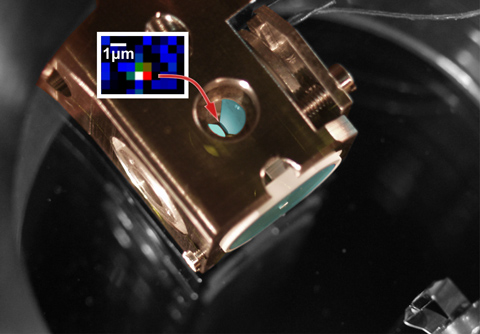A quantum logic gate combining light and matter
April 11, 2014

A single atom is trapped in the narrow gap between two highly reflecting mirrors (light blue) that form an optical resonator. Reflection of single photons from the resonator implements a quantum logic operation between the atom and the photons. (Credit: Andreas Reiserer, MPQ, Quantum Dynamics Division)
Scientists at Max-Planck-Institute of Quantum Optics (MPQ) have successfully achieved a quantum logic gate using a single photon and a single atom.
In the experiment, described in a Nature paper, the binary states 0 and 1 are represented by the two spin orientations of an atom (upwards or downwards), and by two polarization states of an optical photon (left or right circular), respectively.
The atom is trapped inside a cavity made of two mirrors. The properties of the cavity are chosen in such a way that atom and cavity form a strongly coupled system. The light quanta are prepared as faint laser pulses containing less than one photon on average.
The hybrid atom-photon system can act as a classical logic gate that could be a big step towards a universal quantum computer.
“Quantum communication, using flying photons, and data processing with atoms or ions have been regarded as separate research fields so far,” says Prof. Gerhard Rempe, Director at the MPQ and head of the Quantum Dynamics Division. “In our experiment we merge both techniques. In particular, our quantum gate could be easily implemented in a network in which atoms serve as stationary nodes for the storage of information, whereas photons transmit the information between these nodes, even over large distances. In this way we hope to contribute to the realization of a scalable quantum computer.”
Abstract of Nature paper
The steady increase in control over individual quantum systems supports the promotion of a quantum technology that could provide functionalities beyond those of any classical device. Two particularly promising applications have been explored during the past decade: photon-based quantum communication, which guarantees unbreakable encryption but which still has to be scaled to high rates over large distances, and quantum computation, which will fundamentally enhance computability if it can be scaled to a large number of quantum bits (qubits). It was realized early on that a hybrid system of light qubits and matter qubits could solve the scalability problem of each field — that of communication by use of quantum repeaters, and that of computation by use of an optical interconnect between smaller quantum processors. To this end, the development of a robust two-qubit gate that allows the linking of distant computational nodes is “a pressing challenge”. Here we demonstrate such a quantum gate between the spin state of a single trapped atom and the polarization state of an optical photon contained in a faint laser pulse. The gate mechanism presented is deterministic and robust, and is expected to be applicable to almost any matter qubit. It is based on reflection of the photonic qubit from a cavity that provides strong light–matter coupling. To demonstrate its versatility, we use the quantum gate to create atom–photon, atom–photon–photon and photon–photon entangled states from separable input states. We expect our experiment to enable various applications, including the generation of atomic and photonic cluster states and Schrödinger-cat states, deterministic photonic Bell-state measurements, scalable quantum computation7 and quantum communication using a redundant quantum parity code.